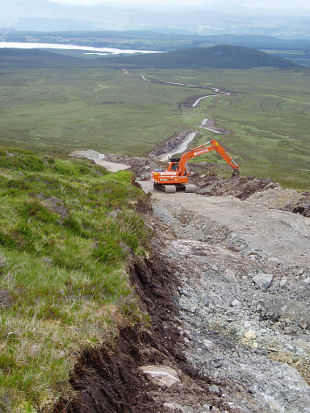
Hill Track on Beinn Bhuraich (Photo: MCofS)
For many years now there has been an increasing proliferation of hill tracks created in some of the most beautiful and relatively untouched areas of Scotland with no form of planning control to consider the public interest in the landscapes being damaged.
This is against the background of an ever-decreasing area of Scotland with a wild feel and free of influence from other development. Former Environment Minister Roseanna Cunningham stated in February that between 2002 and 2009 the extent of Scotland unaffected by any form of visual influence declined from 41% to 28%.
For over four years now the Scottish Government has sat on a recommendation in a report commissioned by the Scottish Executive to address the problem. In an attempt to move the issue forward the MCofS launched a petition last year, leading to a Parliamentary debate. This resulted in a consultation on the General Permitted Development Order, which includes the regulations under which many of the tracks with the greatest impact can be claimed as automatically permitted with no involvement of the planning system.
MCofS President, Chris Townsend, said: “The Scottish Government has sat and looked at this issue for several years. It’s now time for them to get off the fence and control the worst examples of tracks appearing in the wilder areas of Scotland.
“We are at a potential turning point of how hill tracks will be treated in the planning system. The MCofS in its response to Government has emphasised the key issue – there needs to be an appropriate level of scrutiny of the most damaging tracks and to bring these under full control of the planning system by removing them from their current Permitted Development status.”
MCofS Access & Conservation Officer, Hebe Carus, said, “Surely construction of hill tracks in some of our most beautiful wild areas should require more, not less, planning control than a small conservatory in a street full of other conservatories or the new panda enclosure at Edinburgh Zoo.”
The Scottish Government must urgently find a way to deliver control of the most damaging hill tracks that have a disproportionate visual and environmentally damaging impact to the actual area of land on which they are constructed. There is nothing special about hill tracks that mean they should sit outside a planning system that is designed to control the impacts of developments on Scotland.
John Hutchison, chairman of wild land conservation charity the John Muir Trust said, “Wild land is being eroded by the unrestricted development of new vehicle tracks. We recognise that many of these tracks are essential for modern land management, but unless more effective controls are put in place, the ad hoc manner in which they are built and maintained will continue to have an unacceptable impact on our outstanding landscapes.”
